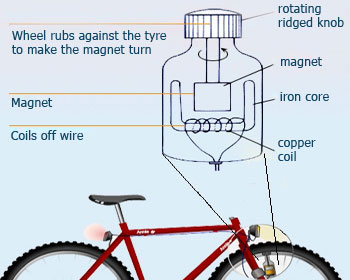 Dynamo
It is a simple generator or machine that transforms mechanical energy into electrical energy. A dynamo in basic form consists of a powerful field magnet where its poles lie in between a suitable conductor, usually in the form of a coil (armature). When there is a change in magnetic field produced due to its movement (to and fro direction or through rotation), an induced current flows through the wire. Thus the mechanical energy of rotation converts into an electric current in the coil which can be used for glowing a filament of the bulb.
Dynamo
It is a simple generator or machine that transforms mechanical energy into electrical energy. A dynamo in basic form consists of a powerful field magnet where its poles lie in between a suitable conductor, usually in the form of a coil (armature). When there is a change in magnetic field produced due to its movement (to and fro direction or through rotation), an induced current flows through the wire. Thus the mechanical energy of rotation converts into an electric current in the coil which can be used for glowing a filament of the bulb.
Up to this point we have seen the interplay between moving charge (electric current) and magnetic field. What would happen on a charge if the magnetic field were to move around?
Michael Faraday, through many experiments, established that though a steady magnetic field cannot produce electricity, a varying magnetic field does. The currents produced in his experiments were small and lasting for a short duration. When he demonstrated his discovery before a gathering, a lady is said to have asked him what use that could be. At that period of time very few applications of electricity were known.
Faraday replied that his discovery was like a new born baby; one cannot know what the baby will achieve after growing up. Faraday's baby has proved to be extraordinarily successful as an adult. It would not be an exaggeration to say that Faraday's discovery was one of the most important discoveries of the 19th century from the point of practical applications of electricity as well as understanding of electromagnetic field. Electrical engineering and electronics have shown the immense potentialities for applications of Faraday's discovery.
Faraday and Henry separately established that electric current can be produced in a wire simply by moving a magnet in or out of a coiled part of the wire. The motion of a magnet in a wire loop itself induces voltage in the loop. No external voltage source or battery is needed. Voltage is caused, or induced by the relative motion between a wire and a magnetic field. Voltage is induced whether the magnetic field of a magnet moves near a stationary conductor or the conductor moves in a stationary magnetic field. In both the cases the voltage induced is the same for the same relative motion.